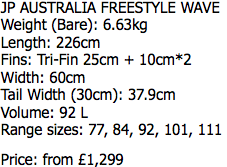Adrian Jones and his test Clones test out the next board in the 2013 freewave test, the JP Australia Freestyle Wave.


 The JP is the shortest board in this test and also one of the smallest at 92 litres. It is the second narrowest (max width) but the tail width is proportionally a little wider, sitting it somewhere in the middle of the group. Weight is very good at 6.63kg’s making it the third lightest in this test. In Pro edition construction it comes standard as a tri-fin, sporting a comparatively large 25cm centre fin and two 10cm thrusters.
The JP is the shortest board in this test and also one of the smallest at 92 litres. It is the second narrowest (max width) but the tail width is proportionally a little wider, sitting it somewhere in the middle of the group. Weight is very good at 6.63kg’s making it the third lightest in this test. In Pro edition construction it comes standard as a tri-fin, sporting a comparatively large 25cm centre fin and two 10cm thrusters.
On the water it definitely feels one of the smallest boards in this group, particularly as the nose is quite short on it. However despite its smaller size, it is one of the quickest onto the plane. It releases exceptionally well and once planing accelerates very rapidly with a noticeable ‘locked down’ and fast feel to it.
Underfoot it has a fantastically compact, exciting and remarkably controlled feel to it. It feels controlled because the nose stays locked down and those 3 fins help to keep the board well planted in the chop and gusts. It’s worth noting however that the shorter, lower nose does make it a little more technical to sail.
For riding, you have to use a bit of pressure to get it to turn but rewarded with a very tight turn and loads of grip.

Top speed is very good – one of the fastest in the group and we only used it as a tri-fin. As a single, it may be even quicker. For jumping it’s fantastic. It planes easily off the beach, accelerates well, hits a high top speed and then in the air feels very light and compact underfoot, thanks to its shorter length. It is definitely a favourite of the Clones when it came to jumping.
On the wave is where this board really excels however. To be honest, it’s probably the best riding freewave board we have ever sailed. The shorter nose does make it a little more technical, particularly in chop, but the turning potential is incredible for a board of this size and orientation. You have to push a little harder than on some to initiate the turn but once done, you are rewarded with an extremely secure and tight bottom turn and arguably the only board in this group that allows you to easily adjust the arc of the turn once committed. The top turn is also probably the tightest and most radical of this group helped in part by the shorter board length and tri-fin set-up. The JP really is bordering on proper wave board territory in terms of riding performance.
Always gives a feeling that it wants to do things. Fast, compact, exciting, great for jumping and manoeuvrable.


For freestyle it was also pretty decent thanks to the low nose, compact proportions and shorter fin configuration. Foot comfort was generally good with the straps fitting extremely snugly on your foot giving good contact and control, plus some nicely padded deck pads.
Really impressive on a wave. Could give some wave boards a run for their money.

TARGET BUYER
The JP was arguably the most radical board in this group. In a straight line, it planes early, is fast, exciting and has good top end control. In the air it was compact, light and really great for jumping. And on the wave it had the most potent performance of this group. Less able riders may find the short and low nose, makes it a bit more technical to ride, but intermediate to advanced riders will love it.
Check out the rest of the Freewave testing series:



